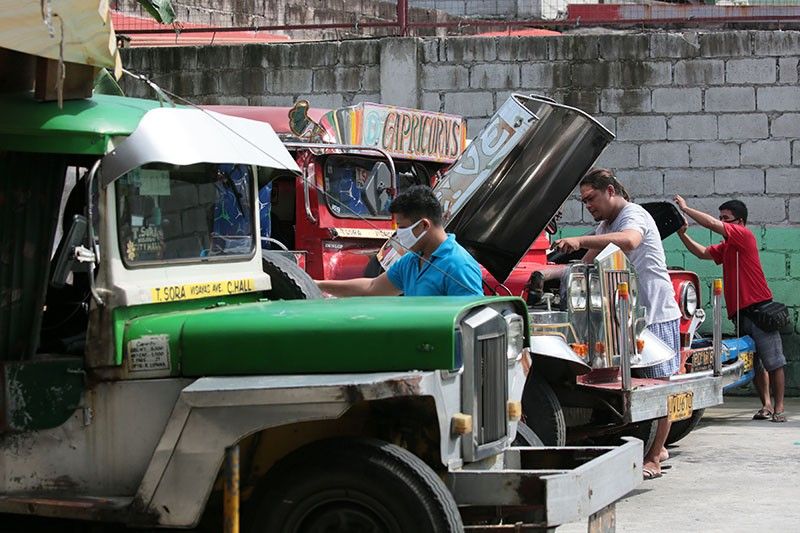Nearly a month into GCQ, gov't uncertain on jeepney's fate

MANILA, Philippines — The return of jeepneys on the road next week is anything but certain with transport officials still unable to provide clear plans how Filipinos’ iconic vehicles will carry passengers, and drivers allowed to earn a living, nearly a month under a more relaxed quarantine regime.
Almost like a script, transport agencies, when asked, have repeatedly cited health risks on riding the “King of the Road” while the threat of coronavirus disease-2019 (COVID-19) infection persists. A solution proposed is a shift to a modernized public utility vehicle (PUV) under a program where drivers, getting fuel subsidies from the government, are asked to pay bank loans slapped with 6% interest.
Apart from infection control, the Department of Transportation also insisted on a “hierarchy” of transport systems, under which jeepneys and UV Express vans come in last because they carry the least passengers— even as smaller tricycles, supervised by cities and municipalities, are already back since June 1.
“Following the hierarchy of transport, traditional jeepneys may be allowed to operate starting next week, when there is a lack in supply of buses, modern PUVs and UV Express,” said Vicky Apacible, the agency’s officer-in-charge for communications.
“Provided, that they comply with roadworthiness standards, as well as health, safety, sanitation, and security protocols,” Apacible said in a text message on Thursday evening.
This latest statement only made the fate of 55,000 traditional jeepneys in the Metro hazier than before. No less than the Land Transportation Franchising and Regulatory Board (LTFRB) said on Wednesday that jeepneys would be allowed back by next week, but when asked how will this be facilitated, the transport department appears unsure, three days before Monday.
“I think what the LTFRB is currently drafting is the guidelines for the operation of UV Express vehicles,” Transport Assistant Secretary Goddes Hope Libiran told reporters on Thursday.
PUV modernization
With the hierarchy enforced, only buses and modern jeepneys were permitted to carry passengers. In Metro Manila, where a more relaxed general community quarantine is in place since June 1, 2,807 buses with 27 varying routes were deployed as of June 18. On top of these, three rail systems currently accepting 10-12% of their typical capacity, are also running, while 90 buses are arranged daily as part of the Metro Rail Transit-3 augmentation program.
For modern jeepneys, 24 routes were opened, but the goal is to open 100. These jeepneys are installed with an automated cash collection systems, a GPS navigation device and use a more environment-friendly fuel, the same vehicles officials want jeepney drivers to partially pay for under the PUV modernization program.
The program, initiated from 2015, has come and go because drivers and operators feeding their poor families refuse to shoulder a large chunk of the P2.4 million price tag of one modernized jeepney. Recently, the government doubled its subsidy for the vehicle to P160,000, but only because the vehicle’s cost also increased. The PUV modernization is being pursued, at this time, when a pandemic is not even allowing drivers to earn a living.
Monica Acha, vice chairman of the Province of Iloilo Transport Service Cooperative, shares the health protocols traditional PUVs under the cooperative imposed to conform to quarantine rules @PhilstarNews pic.twitter.com/3IfarsZLKQ
— Franco Luna (@FrancoOvrboard) June 24, 2020
“Drivers and operators are hoping they can go back to earning a living. They're ready to follow regulations, like putting up dividers in jeeps to ensure the public’s health and safety,” Mody Floranda, national president of Pinagkaisang Samahan ng mga Tsuper at Operator Nationwide (Piston), a transport group, told Philstar.com.
“For three months drivers have suffered without earnings, and for three months the public has had a difficult time without serviceable transport, so we're really hoping we can go back to work,” he said in Filipino.
Shortages
A compromise was offered. The transport department insisted traditional jeepneys can run if current ride options appear insufficient. The agency did not provide data on how many passengers are getting serviced by existing routes, but the need for more transport options is glaring and rising as lockdowns ease.
Since June 1, 23.9 million workers have returned to work nationwide, 58.6% of whom or 14.04 million were located in Metro Manila, Calabarzon, and Central Luzon, areas where workers travel to work from home daily, as well as Cagayan Valley, Central Visayas and Zamboanga.
Heavy traffic could be seen along Commonwealth Ave. in Quezon City after the DOTr approved the resumption of operations of modern jeepneys in Metro Manila under the GCQ.
— Philstar.com (@PhilstarNews) June 22, 2020
????STAR/Boy Santos pic.twitter.com/5HNdSB3iC4
Anecdotal evidence of transport shortage is also not scarce. The government was hit for being unprepared in the first few days of GCQ, with videos and photos of people returning to work swarming the roads to look for rides. The resulting public backlash led to the opening of more bus and modern jeepney routes, but commuter options have remained limited.
“If we assume that 50% of trips resume during COVID-19, there will be 14 million trips by public transport, walking, or cycling. If we continue to stop jeepney operations, around 4.8 million trips will not be served,” Move As One Coalition, a commuter advocacy group, said in a webinar last Wednesday.
- Latest
- Trending
































